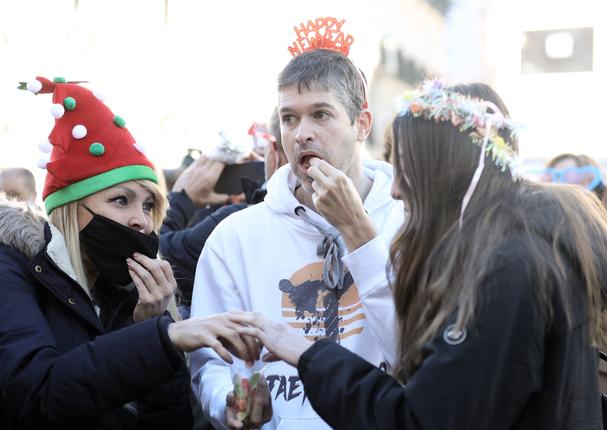These are the traditions, rituals and customs of Hispanic countries to welcome the New Year
En muchas ocasiones (por no decir en la gran mayoría), la conexión cultural entre los países hispanos es más que evidente... y muchos de los rituales que podemos encontrar en un país para dar la bienvenida al nuevo año, se repetirán igualmente en el resto de los países... o al menos se repetirán de una forma bastante parecida. Por ejemplo, lo de comer las doce uvas es un ritual que hacemos casi todos los países hispanos, desde Filipinas hasta España... pasando por Guatemala, Chile, Perú, Argentina, (...).
Actually, the only Hispanic country that leaves the norm is equatorial guinea, where this tradition does not exist (perhaps because getting grapes on the African Atlantic coast is not exactly simple).However, over time, many Ecuadorian guineo residing in Spain have begun to take this custom to their native country.
Of course, in some countries, the tradition of eating the 12 grapes on behalf of the twelve months of next year, it is done in a particular way.For example, in Peru or in Mexico or in Venezuela they do it with yellow underwear, while in Spain we do it with red underwear, and in the meantime, in Argentina they do it with a pink shirt...or in the Philippines where they do it with mole dresses...which is seen as a symbol of prosperity and abundance.
Pyrotechnics is also usually an essential part in New Year's Eve celebrations (this is something we share with almost all countries in the world).However, some cities such as Valparaíso (Chile) take it to the next level, and people from all over the country approach the city to be able to see the majestic spectacle of artificial fires in the front line.
In addition to grapes and fireworks, almost all countries also share some traditions that are worthy of being taken into account.For example, in some countries such as Argentina or Chile there are those who turn on candles of different colors to thank the good things that happened during the past year and to ask for others equally good for the next year.It is a tradition that can also be seen in Spain...But it is very residual.

Colombians, Mexicans, Venezuelans or Chileans also have the habit of walking through their neighborhood loaded with an empty suitcase.With this ritual, they ask the New Year to come loaded with trips and adventures.In some regions of the continent they also have the habit of sweeping the house out, to get all bad energies out of home.
Something that happens specifically in the Caribbean countries, such as Costa Rica, Nicaragua or Puerto Rico, is a thing that - logically - could not be asked for a Hispanic from Patagonia or the Cantabrian: they celebrate the departure of the year giving a dip in the sea.With this tradition, the bad energies that have accumulated during the previous year are removed and face the new year...Both inside and out.This is something that our African brothers of Equatorial Guinea also lead to Rajataba.
In some regions of Puerto Rico it is customary further...And they try to drop back in the sea just when the clock marks 00:00 hours...It is the perfect way to welcome the New Year with well -loaded batteries.
In Puerto Rico and in Cuba it is also believed that throwing a cube of water through the window on the night of December 31 will scare away evil spirits...which apparently is a custom inherited from African religions.Another widespread ritual - although with its variations - is to burn everything bad.Some people in Mexico write on paper all the negative things that have brought them the previous year and then set fire....In this way, they can leave everything behind and start the new year "Free of Equipos".
Some people also manufacture a natural size rag doll and burn it during the night.This tradition can be found not only in Mexico, but also in other countries such as Colombia, in Ecuador or in Peru...Only in the latter he takes advantage of the doll...which usually reminds little characters of politics or entertainment.They are something like Peruvian failures.
Several countries also have some traditions that are unique and that are not repeated in any other country in the Hispanic sphere.For example, in the Philippines the children are encouraged to jump when they give the 12 bells, because it is believed that this will grow high and strong...or in Uruguay, where it is also typical to throw papers and water to the pedestrians from the offices.
Another very interesting ritual takes place in Mexico, and consists of leaving two or three candles lit at night in a white dish with rice seeds, beans or lentils, as well as a little flour and cinnamon in branch.The candles must be on all night of December 31 and the next day everything is buried in the garden, which will bring abundance and good fortune during the next year.
In some areas of the continent they put an egg under the bed before sleeping...And when they wake up they open it to interpret the drawing that makes the yolk.The same do in other places with three potatoes, which also hide under the bed: one of them must be peeled, another peeled medium and another with intact skin.In the morning they extend their hand and - without looking at one of the three.And depending on what the potato they have chosen, they can guess what fortune the year will hold: if the potato they have in their hand is peeled, that will mean that they will be “peeled” during the year...And if the potato still retains the skin, that will mean that it will be a good year (at least as far as money is concerned).
As the reader can check...There are many traditions, customs and rituals that are repeated almost indistinctly in any Hispanic country.However, there is one thing in which we seem that we can never agree: food.While it is true that in all countries it is given capital importance to the family night of New Year's Eve (where Christmas sweets will always occupy a central place), the most absolute diversity is evidence.




